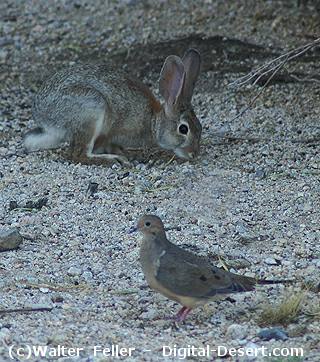Prey Animals
The term prey refers to an animal that is sought, captured, and eaten by a predator. A predator is an animal that hunts and kills other animals for food in an act called predation. Smaller predators, such as mice and lizards can be, and often are, prey for larger predators. The young of larger predators will also become prey. Herbivores, such as rabbits and mule deer, have only defensive adaptations and do not hunt other animals for food or to eliminate them as competition.
-
Desert Cottontail
Desert Bighorn Sheep
Desert Tortoise
Horned Lizard
Antelope Squirrel
Wild Burro
Chuckwalla
Tarantula
Gambel's Quail
Mourning Dove
Jackrabbit

The cottontail rabbit and the mourning dove are both primary consumers and typical prey animals.
|
The Desert Food Chain * Everything has its niche. Who eats what, and what eats who in the desert? Click here to find out what more. |